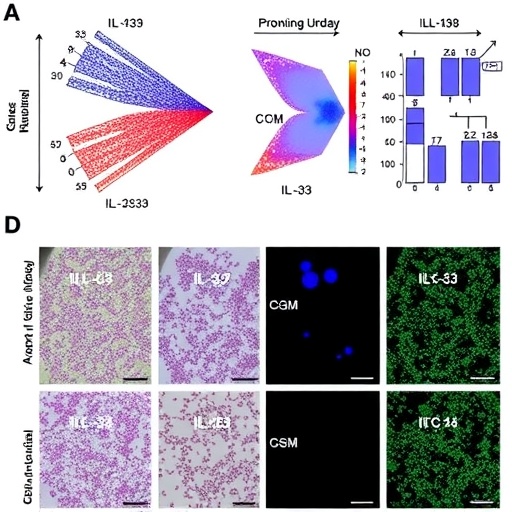In a groundbreaking study that sheds new light on the molecular underpinnings of atopic dermatitis, researchers have identified a pivotal role for IL-33 in priming the NLRP3 inflammasome within basophils to trigger inflammatory cascades. This discovery marks a significant advance in our understanding of the immunological mechanisms initiating atopic dermatitis, a chronic and often debilitating skin disorder that affects millions worldwide. By delineating the crosstalk between IL-33 signaling and inflammasome activation, this novel research opens promising avenues for therapeutic intervention that could fundamentally alter disease management strategies.
IL-33, an epithelial-derived cytokine released upon tissue damage or stress, acts as a danger signal alerting the immune system. Its role in type 2 immune responses has been explored, but this investigation provides compelling evidence that IL-33 directly primes NLRP3 inflammasome components in basophils. This priming leads to the assembly and activation of the inflammasome complex, resulting in the production of interleukin-1 beta (IL-1β), a potent proinflammatory cytokine crucial for the recruitment and activation of other immune cells. Through meticulous in vitro and in vivo analyses, the research demonstrates that this pathway serves as an initiator of the inflammatory milieu characteristic of atopic dermatitis lesions.
.adsslot_Uxcz4p3VuH{ width:728px !important; height:90px !important; }
@media (max-width:1199px) { .adsslot_Uxcz4p3VuH{ width:468px !important; height:60px !important; } }
@media (max-width:767px) { .adsslot_Uxcz4p3VuH{ width:320px !important; height:50px !important; } }
ADVERTISEMENT
This inflammasome activation is significant because IL-1β production has long been implicated in chronic inflammatory diseases, but the specific cellular sources and regulation mechanisms in skin inflammation were less defined until now. The study’s findings emphasize that basophils, upon IL-33 stimulation, become key contributors to the initial cytokine storm that exacerbates skin barrier dysfunction and immune cell infiltration. This paradigm challenges the field to reconsider the immunopathology of atopic dermatitis, shifting the focus to basophils as critical drivers rather than mere responders.
One of the pivotal experimental approaches employed in this research was the use of human and murine models to dissect the functional relevance of the IL-33-NLRP3-IL-1β axis. Through gene knockout and pharmacological inhibition studies targeting NLRP3 and IL-33 signaling, the researchers showed significant attenuation of dermatitis symptoms and lesion development. These findings underscore the therapeutic potential of targeting this axis. Drugs that block IL-33 or components of the inflammasome could potentially arrest disease progression at an early stage, thereby reducing chronicity and improving patient outcomes.
Moreover, this study utilized sophisticated molecular assays, including RNA sequencing and protein interaction analyses, to unravel the downstream signaling events following IL-33 stimulation of basophils. These data revealed that IL-33 primes the inflammasome by upregulating NLRP3 expression and enhancing mitochondrial reactive oxygen species production, a known activator of inflammasome assembly. This multifaceted priming mechanism highlights the complexity of immune regulation in skin inflammation and the delicate balance between protective defense and pathological activation.
The authors also explored the interplay between IL-33-primed basophils and other immune cell populations within the skin microenvironment. Their work suggests that basophil-derived IL-1β acts as an amplifier of local immune responses by recruiting neutrophils and activating dendritic cells. This recruitment amplifies type 2 helper T-cell (Th2) responses, which are central to the pathophysiology of atopic dermatitis. The cascade initiated by basophils hence creates a feedback loop that perpetuates skin inflammation and compromises barrier integrity, contributing to the chronic relapsing nature of the disease.
Importantly, the study’s findings bridge a gap between innate and adaptive immunity in atopic dermatitis. Basophils traditionally occupy a niche in innate immune responses, but their ability to influence Th2 cell polarization through IL-1β production positions them as key modulators in the transition to adaptive inflammation. Understanding this axis is crucial for designing therapies that not only quell inflammation but also restore immune homeostasis in affected skin.
The clinical relevance of this research cannot be overstated. Atopic dermatitis is notoriously heterogeneous, with limited effective treatment options for many patients, particularly those with severe or treatment-resistant disease. By identifying IL-33-primed basophils and the NLRP3 inflammasome as critical components in early inflammation, the study provides tangible targets for next-generation biologics or small-molecule inhibitors. Early intervention in this pathway could prevent the evolution of full-blown dermatitis and potentially reduce the incidence of associated complications such as infections and systemic atopy.
Furthermore, the study highlights the possibility of biomarkers emerging from this pathway to guide diagnosis and treatment. Levels of circulating or skin-derived IL-33, NLRP3 components, or IL-1β may serve as indicators of disease activity or therapeutic response. Personalized medicine approaches leveraging these biomarkers could optimize treatment regimens, sparing patients unnecessary exposure to broad immunosuppressants and their associated risks.
The research also raises provocative questions about the triggers of IL-33 release in the context of atopic dermatitis. Environmental factors, mechanical barrier disruption, or microbial dysbiosis could all contribute to epithelial damage and IL-33 secretion. Understanding these upstream events in greater detail could lead to preventative strategies by mitigating initial epithelial stress or modulating skin microbiota to reduce IL-33-driven basophil inflammasome activation.
In addition to its implications for atopic dermatitis, the study’s insights into IL-33 and NLRP3 inflammasome biology may have broader relevance for other inflammatory and allergic diseases. Conditions such as asthma, allergic rhinitis, and food allergies share similar immunopathological features where IL-33 and inflammasomes have been implicated. The identification of basophils as central players could summarize a unifying mechanism across these conditions, supporting the development of shared therapeutic targets.
The methodology’s rigorous approach strengthens the study’s conclusions, combining histological examination, flow cytometry, cytokine quantification, and genetic manipulation. This comprehensive toolkit provides an in-depth view of cellular and molecular events occurring during dermatitis initiation. Such integrative studies are essential to move beyond correlative findings towards causal understanding, thereby informing rational drug design.
This research also exemplifies the critical importance of revisiting so-called lesser-known immune cells, such as basophils, in disease pathogenesis. For decades, basophils were overshadowed by mast cells and eosinophils in allergic inflammation research. This work revitalizes interest in basophils, revealing their multifaceted functions and positioning them at the forefront of inflammatory skin diseases. Future studies will undoubtedly explore the diverse roles these cells play in immunity, potentially unveiling novel pathophysiological pathways.
Finally, the study’s publication comes at a time when the field of dermatological immunology is rapidly expanding, driven by technological advances and translational research. As personalized treatments and biologics revolutionize care, findings like these highlight new targets and mechanisms by which skin inflammation may be controlled more precisely and safely. The combination of basic science and clinical insight presented here underscores the importance of continued investment in fundamental immunological research to tackle complex chronic diseases.
In summary, the identification of IL-33-primed NLRP3 inflammasome activation within basophils as an initiator of atopic dermatitis inflammation offers a fresh perspective on disease mechanisms. This pathway not only advances scientific understanding but also highlights novel therapeutic and diagnostic possibilities that could transform patient care. As the immunology community continues to unravel the complexities of skin inflammation, this study stands as a landmark contribution, heralding new directions for research and treatment in atopic dermatitis and beyond.
Subject of Research: The role of IL-33-primed NLRP3 inflammasome activation in basophils as a driver of IL-1β production and the initiation of atopic dermatitis inflammation.
Article Title: IL-33-primed NLRP3 inflammasome in basophils drives IL-1β production and initiates atopic dermatitis inflammation.
Article References:
Gunji, Y., Matsumura, T., Karasawa, T. et al. IL-33-primed NLRP3 inflammasome in basophils drives IL-1β production and initiates atopic dermatitis inflammation. Cell Death Discov. 11, 346 (2025). https://doi.org/10.1038/s41420-025-02630-6
Image Credits: AI Generated
DOI: https://doi.org/10.1038/s41420-025-02630-6
Tags: basophils and inflammatory responseschronic skin disorders and immune activationcytokine signaling in skin inflammationIL-33 in atopic dermatitisimmune mechanisms of eczemainflammasome activation in allergic diseasesmolecular mechanisms of atopic dermatitisNLRP3 inflammasome in basophilspriming basophils for immune responserole of alarmin cytokines in inflammationtherapeutic targets for eczemaunderstanding basophil function in skin disorders





